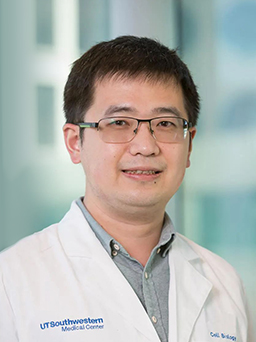
特聘研究员
结构生物学
guilong(at)smart.org.cn
原位结构生物学,相比较传统的结构生物学方法,聚焦于生物分子在其原生环境中的结构,可以进一步了解生物大分子在细胞内部相互作用的真实情况,有助于疾病机制的理解并促进新治疗方法的开发。桂龙课题组目前正致力于进一步运用和发展原位生物学技术,深入研究对人类健康至关重要的大分子复合体。研究重点包括探索人类罕见病的结构基础以及流感病毒如何通过膜融合机制侵入细胞等。为了推进这一创新性研究领域,课题组计划组建一个大约由10名成员组成的多元化团队,成员涵盖副/助理研究员、博士后、研究生、研究助理以及访问学生。课题组秉承自由、开放、包容的学术理念,追求科学研究的广度与深度,为每位团队成员提供支持和鼓励。桂龙博士期待具有热情和才能的科研人员加入团队,共同在这一激动人心的研究领域实现突破和进展。
桂龙博士长期致力于综合运用多种结构生物学研究手段(如冷冻电镜断层成像、冷冻聚焦离子束、光电联合成像、子断层图像平均等)研究生物大分子复合体的原位结构与功能。近十年来,桂龙博士采用冷冻电子断层(Cryo-electron tomography, Cryo-ET) 以及相关的电子显微镜技术,取得了一系列的研究成果,包括: (1)揭示了弓形虫顶复合体的原位结构及其与外分泌系统的紧密联系;(2)重构了真核细胞运动纤毛中动力蛋白调节复合体(N-DRC)的高分辨率三维结构, 并阐明了相关纤毛病的机理;(3) 探究了真核细胞中脂滴在应激条件下的相变过程;(4)以囊膜病毒为例,通过原位结构生物学方法解析了病原微生物如何入侵宿主细胞的过程等。
2024 - 至今深圳医学科学院 特聘研究员
2017 - 2023德克萨斯大学 西南医学中心 博士后
2016 - 2017华盛顿大学 博士后
2009 - 2016华盛顿大学 博士
2005 - 2009中国科学技术大学 生命科学学院 本科
2013 玛格丽特·R·戴维斯研究生奖学金
2008 优秀本科生奖学金
2007 优秀本科生奖学金
2006 光华教育奖学金
2005 优秀本科生奖学金
*代表共同第一作者
1.Gui, L., O’Shaughnessy, W.J., Cai, K., Reetz, E., Reese, M.L. and Nicastro, D., 2023. Cryo-electron tomography of the apicomplexan invasion machinery in its native state reveals rigid body motion of the conoid and docked secretory machinery. Nature Communications, 14(1):1775
2.Rogers, S.*, Gui, L.*, Kovalenko, A.*, Zoni, V.*, Carpentier, M., Ramji, K., Ben Mbarek, K., Bacle, A., Fuchs, P., Campomanes, P. and Reetz, E., 2022. Triglyceride lipolysis triggers liquid crystalline phases in lipid droplets and alters the LD proteome. Journal of Cell Biology, 221(11), p.e202205053.
3.Pinskey, J.M., Lagisetty, A., Gui, L., Phan, N., Reetz, E., Tavakoli, A., Fu, G. and Nicastro, D., 2022. Three-dimensional flagella structures from animals’ closest unicellular relatives, the Choanoflagellates. Elife, 11, p.e78133.
4.Gui, L., Song, K., Tritschler, D., Bower, R., Yan, S., Dai, A., Augspurger, K., Sakizadeh, J., Grzemska, M., Ni, T. and Porter, M.E., 2019. Scaffold subunits support associated subunit assembly in the Chlamydomonas ciliary nexin–dynein regulatory complex. Proceedings of the National Academy of Sciences, 116(46), pp.23152-23162.
5.Stoddard, D., Zhao, Y., Bayless, B.A., Gui, L., Louka, P., Dave, D., Suryawanshi, S., Tomasi, R.F.X., Dupuis-Williams, P., Baroud, C.N. and Gaertig, J., 2018. Tetrahymena RIB72A and RIB72B are microtubule inner proteins in the ciliary doublet microtubules. Molecular Biology of the Cell, 29(21), pp.2566-2577.
6.Gui, L. and Lee, K.K., 2018. Influenza virus-liposome fusion studies using fluorescence dequenching and cryo-electron tomography. Influenza Virus: Methods and Protocols, pp.261-279.
7.Gui, L., Ebner, J.L., Mileant, A., Williams, J.A. and Lee, K.K., 2016. Visualization and sequencing of membrane remodeling leading to influenza virus fusion. Journal of virology, 90(15), pp.6948-6962.
8.Gui, L., Jurgens, E.M., Ebner, J.L., Porotto, M., Moscona, A. and Lee, K.K., 2015. Electron tomography imaging of surface glycoproteins on human parainfluenza virus 3: association of receptor binding and fusion proteins before receptor engagement. MBio, 6(1), pp.10-1128.
9.He, Y.X., Gui, L., Liu, Y.Z., Du, Y., Zhou, Y., Li, P. and Zhou, C.Z., 2009. Crystal structure of Saccharomyces cerevisiae glutamine synthetase Gln1 suggests a nanotube‐like supramolecular assembly. Proteins: Structure, Function, and Bioinformatics, 76(1), pp.249-254.